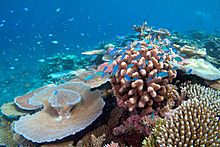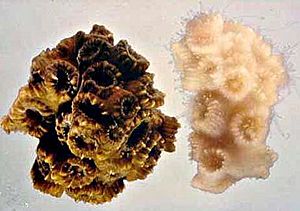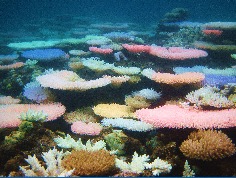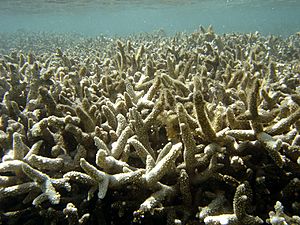Coral bleaching facts for kids
Coral bleaching happens when stony corals turn white. It's a big problem for coral reefs around the world.
Stony corals are tiny animals that build huge reefs. These animals live in a special partnership, called endosymbiosis, with tiny, single-celled algae. To get sunlight, corals live close to the sea level. The algae make food for the coral polyps using sunlight, a process called photosynthesis.
Coral polyps are very sensitive to changes in their home, especially the water temperature. When they get stressed, coral polyps can kick out the algae living inside them. These algae provide up to 90% of the coral's energy! Bleached corals are still alive, but they start to starve. Some corals can get better, but many die.
Warmer ocean temperatures, caused by global warming, are the main reason for coral bleaching.
The United Nations Environment Programme reported that the longest global bleaching events ever happened between 2014 and 2016. A huge amount of coral died during this time. For example, in 2016, between 29% and 50% of the coral on the Great Barrier Reef was killed. The time between these bleaching events has become much shorter, almost half, between 1980 and 2016.
Some corals don't just turn white when they bleach; they can change to very bright colors. In May 2020, scientists found that these colors might act like sunscreen. They could protect the coral cells from too much light. This might help the coral survive until the algae can return.
Contents
What Makes Corals Bleach?
Many things can cause coral bleaching. The biggest bleaching events in recent years have been caused by global warming. Scientists expect corals to become much rarer on reefs if carbon dioxide levels keep rising. Coral reefs in warm, shallow water with slow currents are often affected more than those in areas with stronger water flow.
Common Causes of Bleaching
Here are some common reasons why corals bleach:
- Warmer or colder water: Most often, very warm water (called marine heatwaves) due to global warming causes bleaching. But very cold water can also cause it.
- Too much sunlight: Strong sunlight, especially UV light, can stress corals.
- Pollution:
- Sediment: Too much silt or dirt washing into the ocean from land.
- Chemicals: Things like herbicides, oil spills, or certain ingredients in sunscreen (like oxybenzone).
- Changes in water chemistry: An imbalance of nutrients like nitrate and phosphate.
- Other stresses:
- Bacterial infections.
- Changes in how salty the water is (salinity).
- Very low tides that leave corals exposed to the air.
- Harmful fishing methods, like cyanide fishing.
- Mineral dust from large dust storms.
- Ocean acidification, which happens when the ocean absorbs too much CO2 from air pollution.
How Climate Change Affects Corals
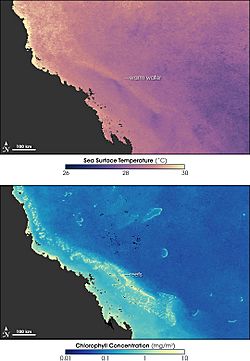
The warming of the ocean's surface can lead to coral bleaching. This can cause serious damage and even kill corals.
Experts warned about this problem back in 2007. The Intergovernmental Panel on Climate Change (IPCC) said it was the biggest threat to the world's coral reefs.
The Great Barrier Reef had its first big bleaching event in 1998. Since then, bleaching has happened more often. There were three major events between 2016 and 2020 alone. Scientists predict that if global warming is kept to 1.5°C, the Great Barrier Reef will bleach three times every ten years. If warming reaches 2°C, it could bleach every other year.
In 2017, National Geographic reported that 25 reefs, making up three-fourths of the world's reef systems, had severe bleaching. Scientists called it the worst series of bleaching events ever recorded.
Big Bleaching Events
Between 1979 and 1990, there were sixty major coral bleaching events. These events caused coral deaths on reefs all over the world. The longest coral bleaching event ever recorded happened from 2014 to 2017. This was linked to a strong El Niño weather pattern. During this time, over 70% of the world's coral reefs were damaged.
Clive Wilkinson, from the Global Coral Reef Monitoring Network, noted that the mass bleaching in the Indian Ocean in 1998 was due to sea temperatures rising by 2°C. This happened along with the strong El Niño event of 1997–1998.
In April 2024, the NOAA confirmed a fourth global coral bleaching event. The percentage of affected coral reefs worldwide for each of the four events has been estimated at 20%, 35%, 56%, and 54%.
Impacts of Bleaching
When coral bleaching events happen, the number of different fish species goes down. This then affects the entire coral reef ecosystem, which relies on healthy corals.
Images for kids
-
Zooxanthellae are the tiny algae that live inside coral. They give coral its color and make food through photosynthesis.
-
A major coral bleaching event happened on this part of the Great Barrier Reef in Australia.
See also
 In Spanish: Blanqueo del coral para niños
In Spanish: Blanqueo del coral para niños



